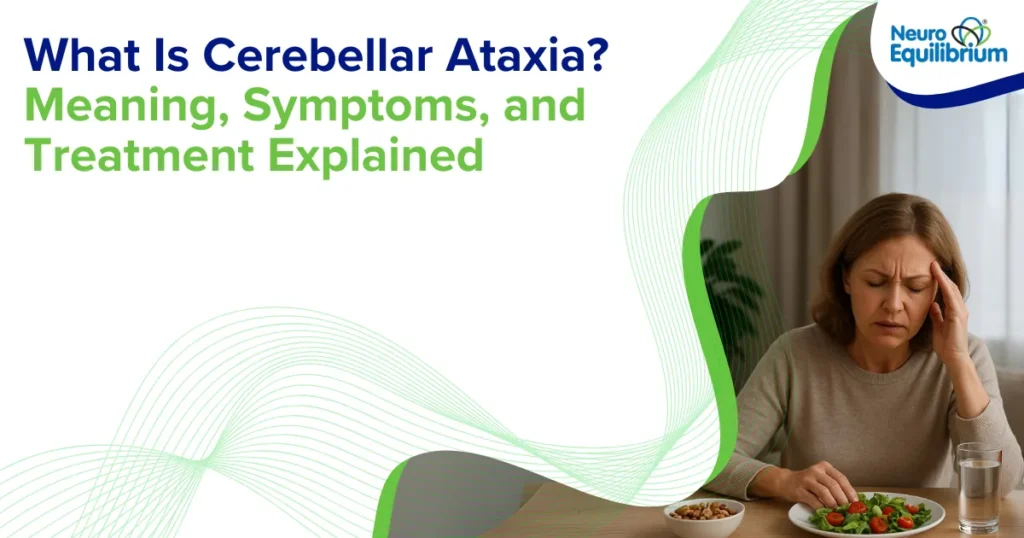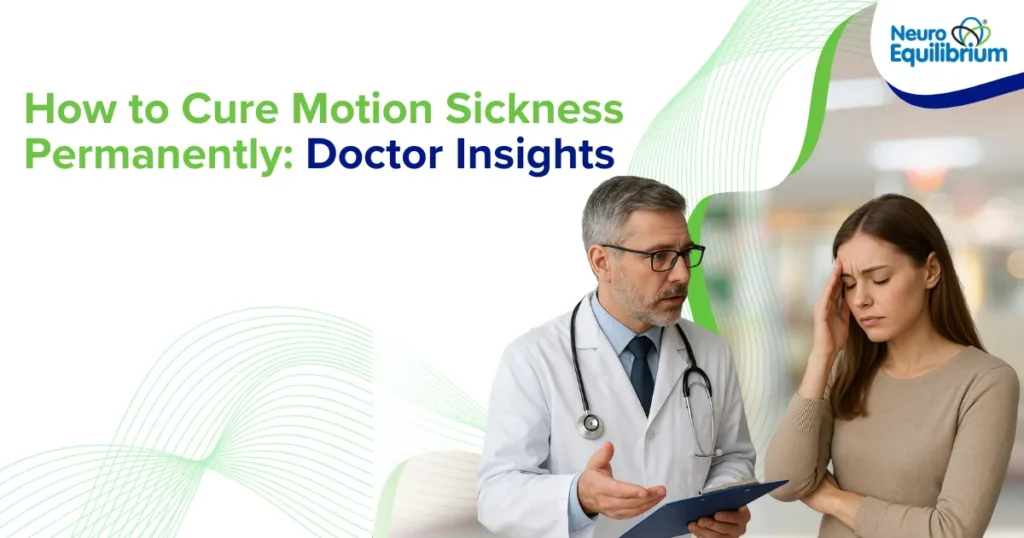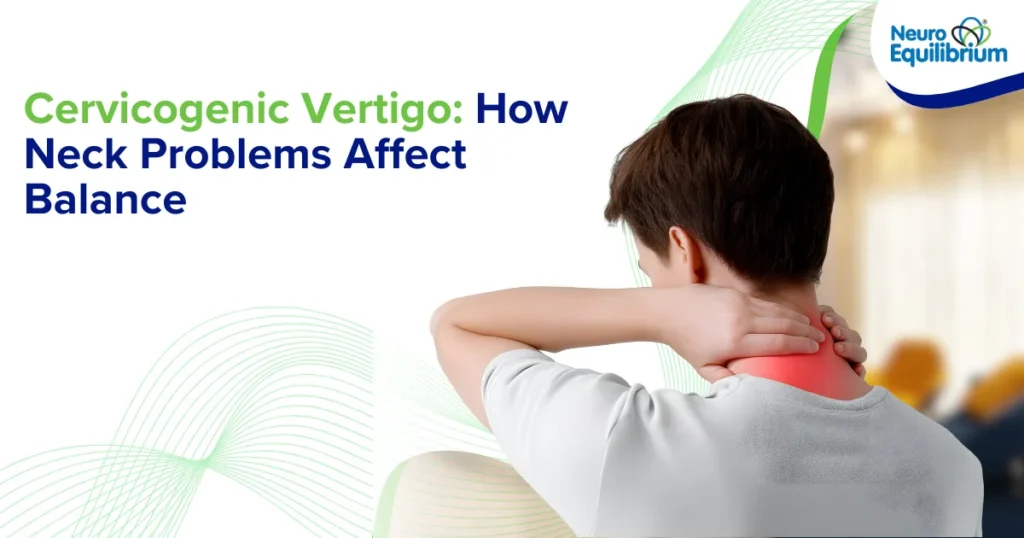Understanding Vertigo and When to Get Checked
Even when you’re still, vertigo can make it feel like the world is spinning around you. This happens when the body’s balance system, mostly located in the inner ear, isn’t working quite right. Inside your inner ear, there are tiny structures and tiny calcium crystals that help us sense movement and keep our balance. When the messages sent to your brain get mixed up, it can create feelings of movement or dizziness.
If your dizziness comes back, it’s a good idea to see a vertigo specialist. They can help find the real cause, rather than just giving you medication for temporary relief. If vertigo is paired with warning signs like sudden severe dizziness, headache, blurred vision, slurred speech, weakness, or trouble walking, seek medical attention right away which could be signs of a more serious issue, like a stroke. It’s also wise to see a professional if dizziness is triggered by head movements, lasts a long time, affects your balance, or is accompanied by hearing problems. An expert’s assessment can lead to the right tests and treatments, helping you find relief and possibly a permanent solution.
At NeuroEquilibrium, a dedicated team of ENT doctors, neurologists, and Vestibular physiotherapists uses the latest diagnostic tools to pinpoint the exact problem and develop a personalized plan for your recovery treatment.
Know More About Vertigo
What Happens During a Vertigo Evaluation
We understand that dizziness or the sense that you are spinning may be quite uncomfortable. The purpose of our vertigo assessment exam is to diagnose the specific cause of your condition and create the most effective treatment plan. This may additionally mean that vertigo could be brought about by an enormous number of disorders of the inner ear, brain, or even by general health and we are therefore offering a comprehensive, holistic, and highly personalized approach.
Step 1: Understanding Your Symptoms and Medical History
Your evaluation begins with an in-depth discussion and a physical examination.
- Listening to your experience: Our professionals listen to your experience of dizziness. We inquire about the onset of the same, the duration of the same and what makes it better or worse. You can tell about anything that could be relevant, whether it is movements, stress, or even particular foods that seem to cause it.
- Balance check and coordination: We do a physical and a neurological examination, to establish to what extent your balance system is performing or underperforming. One of the important parts of this step is the eye-test because there are certain eye movements called as nystagmus, which could be a sign of inner ear damage related to balance.
Step 2: Advanced Balance and Hearing Tests
At our clinics, we use advanced diagnostic technology to measure how your inner ear and brain work together to maintain balance. These tests are safe, non-invasive, and provide valuable insights into the source of your vertigo.
| Test | What It Shows | What You Can Expect |
| Videonystagmography (VNG) | How your eyes and inner ear coordinate to control balance. | You wear goggles with small cameras while following lights or moving your head gently. |
| Positional Testing (such as Dix–Hallpike) | Whether vertigo is caused by tiny crystals in your inner ear (BPPV). | The doctor moves your head and body into specific positions to check if dizziness and eye movements occur. |
| Subjective Visual Vertical (SVV) | How accurately your brain perceives upright position. | You adjust a line on a screen until it looks perfectly straight to you. |
| Dynamic Visual Acuity (DVA) | How clearly you can see while your head is moving. | You read letters or symbols on a screen while turning your head side to side. |
| Video Head Impulse Test (vHIT) | How your semicircular canals respond to quick head movements. | You wear special goggles while the doctor makes small, quick head turns. |
| Audiometry (Hearing Test) | Whether hearing loss is linked to your dizziness. | You wear headphones and respond to a range of sounds and tones. |
| Posturography | How well you maintain posture and balance in different situations. | You stand on a platform that measures your body’s movements and stability. |
Step 3: Additional Assessments if Needed
Depending on your initial results, we may recommend further tests to ensure a complete understanding of your condition.
- Blood Pressure Measurement: Blood pressure and pulse are measured when lying down and standing. This assists in the diagnosis of postural hypotension that leads to dizziness upon standing up.
- Imaging Scans (MRI or CT): This can be performed in rare conditions only to examine the brain and inner ear in more detail and eliminate central causes like stroke or multiple sclerosis.
- Blood Tests: Another way to determine other causes of dizziness is to take blood tests to determine if the person has anemia, thyroid imbalance, or vitamin deficiencies.
At NeuroEquilibrium clinics, after your assessment, our caring experts will discuss the results with you and work together on a personalized plan. This plan might include repositioning exercises, vestibular rehabilitation treatment (VRT), medications, and lifestyle changes, all tailored to your needs. Our goal is to restore your balance, boost your confidence, and bring comfort back into your daily life.

Your Personalized Vertigo Treatment Plan
Vertigo is not a disease on its own, but it is a symptom which can be caused by a great number of things. Since the balance system is impacted by each condition in a unique way, your treatment plan is created with your needs in mind. We are multi-disciplinary and can involve treatment plans which contain physical maneuvers, rehabilitation therapy, medication and changes in lifestyle.
1. Repositioning Maneuvers
In the case of Benign Paroxysmal Positional Vertigo (BPPV), where calcium crystals are found in the inner ear, they move out of position, requiring the most effective treatment to be repositioning maneuvers. These are non-complicated, controlled head and body motions that aid to push the displaced crystals into where they are supposed to be.
- When done well, such maneuvers can make the difference, and the success rates will be really high (usually 80-90 percent success).
- The maneuver will depend on the diagnostic test result.
- Common maneuvers include:
- Epley’s Maneuver (Canalith Repositioning) – most effective for Posterior Canal BPPV
- Semont’s Maneuver (Liberatory Maneuver) – an alternative for the same condition
- Barbeque Roll or Zuma Maneuver – used for Horizontal Canal BPPV
At our clinics, these are performed with the help of advanced 3D guidance systems to ensure accuracy and comfort.
2. Vestibular Rehabilitation Therapy (VRT)
Vestibular Rehabilitation Therapy is a personalized form of exercise which is used to assist your brain to adjust and restore balance when the inner ear is not operating as it is supposed to. Particularly, it is beneficial in such conditions as Vestibular Neuritis, peripheral vestibulopathy, or persistent dizziness following treatment with the BPPV.
- Purposes: To enhance balance, stability, and body-eye coordination and minimize dizziness.
- Exercises: It should consist of gaze stabilization exercises, balance exercises, and coordination exercises.
- Technology: We apply Virtual Reality (VR) modules to make the treatment process more interesting. Such exercises are VR based and recreate the conditions of the real world, including walking on uneven surfaces or maneuvering in a crowded space to provide balance.
Patients can also continue their exercises at home using the NeuroEquilibrium app, which supports long-term recovery and consistency.
3. Medications
Medication can help manage severe symptoms or treat specific underlying causes, but it is usually a short-term part of treatment rather than a permanent solution.
- In the short term, vestibular suppressants could be used to eliminate the feeling of spinning.
- In the case of Vestibular Neuritis, steroids could be used to decrease the inflammation.
- Diuretics are used to treat Meniere’s disease to lower the pressure in the inner ear.
- Migraine-preventive medication can also be used to treat vestibular migraine.
Your doctor carefully selects medications to match your diagnosis and monitors your progress closely.
4. Lifestyle and Dietary Modifications
Simple lifestyle changes can make a big difference in controlling vertigo symptoms and preventing recurrences.
| Goal/Condition | What Helps | Why It Matters |
| Meniere’s Disease | Reduce salt intake | Helps maintain fluid balance in the inner ear |
| Vestibular Migraine | Avoid trigger foods like cheese, chocolate, red wine, caffeine, and MSG | Reduces migraine-related dizziness |
| Overall Health | Stay well-hydrated and get 7–9 hours of sleep | Supports blood flow and recovery |
| Stress-Related Dizziness | Use relaxation techniques such as yoga or meditation | Reduces anxiety that worsens symptoms |
| Postural Dizziness | Change positions slowly and manage blood pressure | Prevents sudden lightheadedness |
| BPPV Prevention | Maintain adequate Vitamin D levels | May lower the risk of recurrence |
Our team provides guidance on diet, hydration, and lifestyle habits that support long-term balanced health.
5. Cognitive Behavioral Therapy (CBT)
Cognitive Behavioral Therapy may be quite useful to patients who experience active dizziness or fear of falling. CBT makes you realize that your thoughts and feelings affect your physical symptoms.
- Concentration: Makes you feel more confident, lessens the fear of falling, and enables you to feel under control of your balance again.
- Approach: It involves relaxation training, breathing, and gradual exposure to the provoking activities.
- Outcomes: The majority of patients can report a high percentage of improvement after a period of four to six sessions.
6. Fall Prevention and Safety
For older adults or those with chronic imbalance, preventing falls is an essential part of care.
- Rehabilitation exercises improve strength, posture, and flexibility.
- Home safety checks help identify risks such as poor lighting or loose rugs.
- Medication review ensures that prescriptions do not worsen dizziness or drowsiness.
7. Surgical Treatment (When Necessary)
A vertigo surgery is an uncommon procedure that is done after the other options have failed. Such disorders as Perilymph Fistula, Superior Semicircular Canal Dehiscence (SSCD) or Acoustic Neuroma can be corrected surgically. These options will be explained by your doctor in case there is a need.
Recovery and Results
After your doctor has evaluated you, they’ll create a personalized plan that might include: Canalith repositioning techniques like Epley or Semont, Vestibular rehab exercises using the NeuroEquilibrium app, medications such as anti-nausea, migraine, or ear pressure treatments, and lifestyle adjustments like focusing on diet, staying hydrated, and improving sleep. Most patients notice positive changes within three to six weeks of consistent therapy and treatment. At NeuroEquilibrium Clinics, we’re dedicated to helping you regain your balance, confidence, and a sense of normalcy in your daily life.
How to Book an Appointment
You can book online in just a few steps:
- Visit Clinics Finer Page: https://www.neuroequilibrium.in/our-partner-clinics/
- Choose your city
- Pick a date and time
- Receive instant confirmation by SMS or WhatsApp
Or call +91-74280-99888 to book directly.
Find a NeuroEquilibrium Vertigo Clinic Near You
Choose your nearest city below to locate a certified NeuroEquilibrium® partner clinic:
Madhya Pradesh
Ujjain | Barwani | Sagar | Indore | Jabalpur | Bhopal
Maharashtra
Miraj | Kolhapur | Nashik | Jaysingpur | Amravati | Solapur | Pune | Aurangabad | Nagpur | Sangli
Bihar & Chhattisgarh
Patna | Bilaspur
Gujarat
Ahmedabad | Vadodara | Surat
Maharashtra (Mumbai Region)
Navi Mumbai | Thane | Mumbai | Palghar
Rajasthan
Jaipur | Sriganganagar | Alwar | Kota | Udaipur
Uttar Pradesh
Lucknow | Prayagraj | Varanasi
Delhi NCR & North India
Gurgaon | Greater Noida | Delhi | Dehradun | Rohtak | Amritsar | Ludhiana
South India
Kannur | Trichur | Cochin | Coimbatore | Tiruppur | Chennai | Hosur | Bangalore | Mangalore | Hyderabad
Why Choose NeuroEquilibrium
At NeuroEquilibrium Clinics, we’re truly dedicated to helping each patient find lasting relief from vertigo. As India’s largest network of vertigo and balance centers, we combine expert medical knowledge with advanced diagnostic tools to understand exactly why you’re feeling dizzy. Our treatment plans are thoughtfully customized for each person, focusing on long-term recovery rather than quick fixes. When you choose NeuroEquilibrium, you’re opting for precision, innovation, and caring, dependable support. Book an appointment today.
What is the best doctor to see for vertigo?
A Neurotologist is the best physician to visit due to vertigo and is a specialist in inner ear, balance system and other related neurological strategies. Neurotologists have special training to identify the cause of vertigo as being either of the ear, brain or nervous system. In the NeuroEquilibrium Clinics, we have Neurotologists, ENT specialists, and Neurologists and all these experts collaborate to offer a well-rounded assessment and proper diagnosis of any type of dizziness and imbalance.
What is the newest treatment for vertigo?
The recent treatments aim at the discovery of the precise cause of vertigo using sophisticated diagnostic instruments and providing specific therapies. In NeuroEquilibrium Clinics, patients get 3D-guided repositioning, Vestibular Rehabilitation Therapy (VRT) using Virtual Reality and designed home exercise programs via the NeuroEquilibrium app. These advanced and patient friendly therapies aid in restoration of balance more rapidly and in minimizing reoccurrence.
Should I go to an ENT or a neurologist for vertigo?
ENT specialists as well as neurologists treat vertigo, however, the appropriate option is based on the cause. The inner ear and balance system deal with conditions managed by ENT specialists and the neurologists deal with vertigo which is a problem associated with the brain or nerve disorder. In NeuroEquilibrium Clinics, the two categories of specialists are in one roof and thus you are able to get coordinated care as well as a comprehensive one without having to travel to several clinics to get the same care.
Can I go to a walk-in clinic for vertigo?
To achieve immediate relief of the symptoms, a walk-in clinic can be effective, as they will be able to address minor problems in the short term. Nevertheless, to achieve a longer-term success, it is better to visit a special vertigo clinic where the diagnosis and treatment can be considered in-depth. Neuroequilibrium clinics have more than 54 locations in India and offer all types of vertigo tests and treatment near your location so that you get the best care when you need it.
What tests are done for vertigo?
At NeuroEquilibrium Clinics, we use a specialized Vertigo Profile Test to accurately determine the cause of dizziness. This includes safe and non-invasive tests such as Videonystagmography (VNG) to assess eye movements, Video Head Impulse Test (vHIT) to evaluate inner ear function, Dynamic Visual Acuity (DVA) and Subjective Visual Vertical (SVV) to test visual balance, and Posturography to measure posture control. These tests help our Neurotologists pinpoint whether vertigo arises from the ear, brain, or balance system, enabling precise diagnosis and personalized treatment.
















